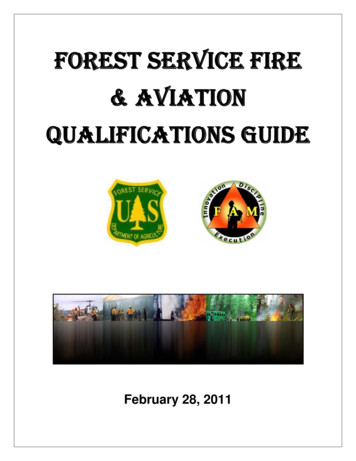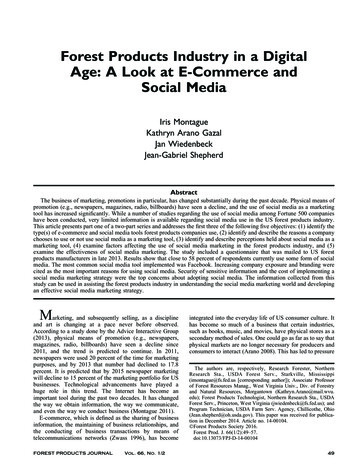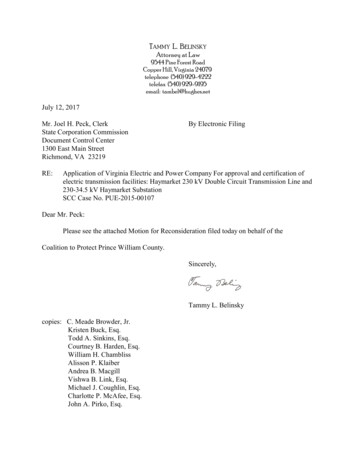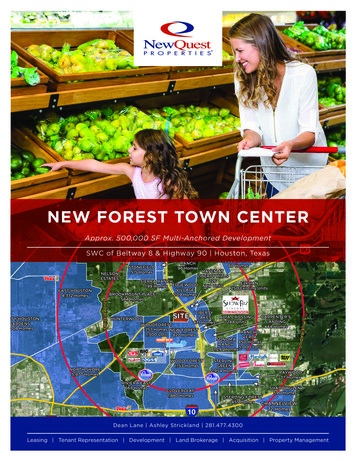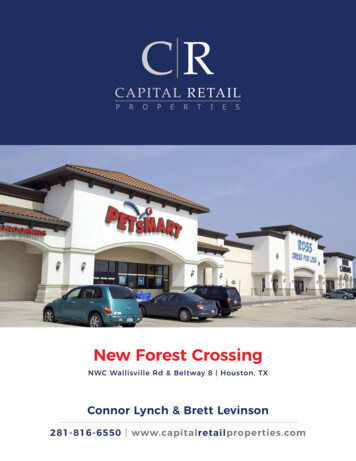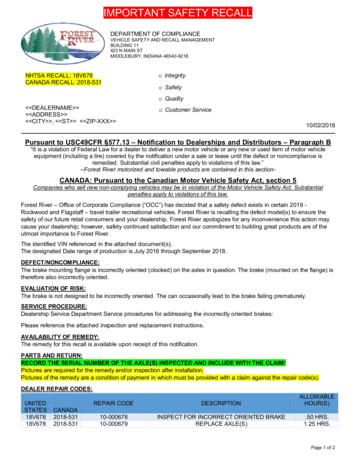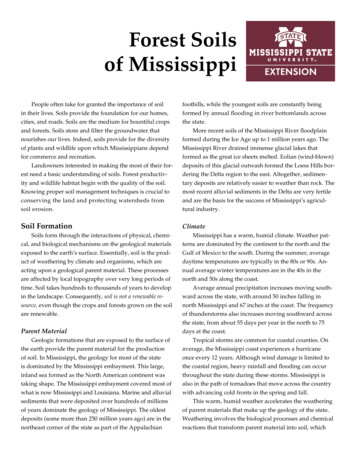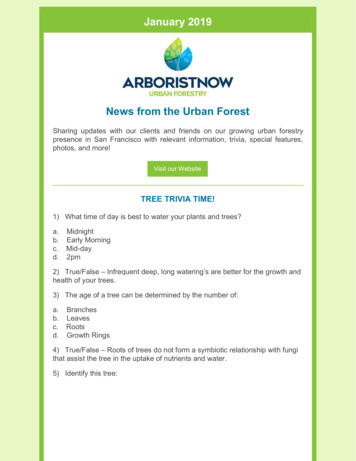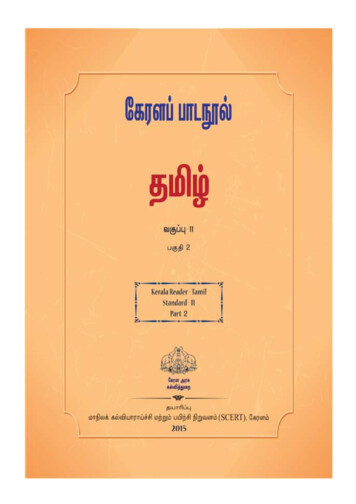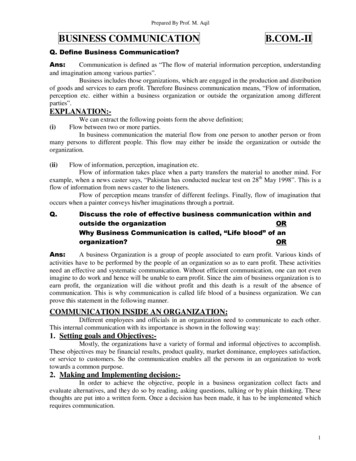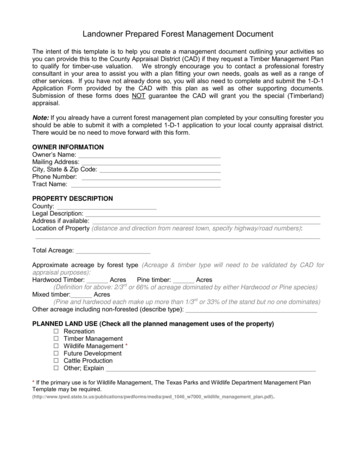
Transcription
Landowner Prepared Forest Management DocumentThe intent of this template is to help you create a management document outlining your activities soyou can provide this to the County Appraisal District (CAD) if they request a Timber Management Planto qualify for timber-use valuation. We strongly encourage you to contact a professional forestryconsultant in your area to assist you with a plan fitting your own needs, goals as well as a range ofother services. If you have not already done so, you will also need to complete and submit the 1-D-1Application Form provided by the CAD with this plan as well as other supporting documents.Submission of these forms does NOT guarantee the CAD will grant you the special (Timberland)appraisal.Note: If you already have a current forest management plan completed by your consulting forester youshould be able to submit it with a completed 1-D-1 application to your local county appraisal district.There would be no need to move forward with this form.OWNER INFORMATIONOwner’s Name:Mailing Address:City, State & Zip Code:Phone Number:Tract Name:PROPERTY DESCRIPTIONCounty:Legal Description:Address if available:Location of Property (distance and direction from nearest town, specify highway/road numbers):Total Acreage:Approximate acreage by forest type (Acreage & timber type will need to be validated by CAD forappraisal purposes):Hardwood Timber: AcresPine timber: Acres(Definition for above: 2/3rd or 66% of acreage dominated by either Hardwood or Pine species)Mixed timber: Acres(Pine and hardwood each make up more than 1/3rd or 33% of the stand but no one dominates)Other acreage including non-forested (describe type):PLANNED LAND USE (Check all the planned management uses of the property) Recreation Timber Management Wildlife Management * Future Development Cattle Production Other; Explain* If the primary use is for Wildlife Management, The Texas Parks and Wildlife Department Management PlanTemplate may be /pwdforms/media/pwd 1046 w7000 wildlife management plan.pdf).
If use is for Timber Management check all that apply: I have sold timber in the past I plan to sell timber in the future I employ a professional forestry consultantI am a member of these organizations: Tree FarmTree Farm Number (If available): County Forest Landowner Association Texas Forestry AssociationI have received cost-share assistance for reforestation or timber stand improvement: Yes NoIf yes, please check program below: Texas Reforestation Foundation (TRe) Environmental Quality Incentive Program (EQIP) Forest Landowner Enhancement Program (FLEP) Conservation Reserve Program (CRP) Texas Forest Service Southern Pine Beetle Prevention Program Other :All or portions of the property are enrolled in one or more of these conservation programs: Wetland Reserve Program (WRP) Conservation Reserve Program (CRP) Wildlife Habitat Incentive Program (WHIP) Other:Supplying the above information is voluntary, but helps to document that you are actively engaged intimber management. The Texas Constitution permits timber-use valuation only if the property and itsowner meet specific requirements defining timber use. Land will not qualify simply because it hastimber standing on it. In addition, timberland that is used principally for aesthetic or recreationalpurposes (other than wildlife management) will not qualify. The Texas Tax Code, Section 23.72, setsthe standards for determining whether land qualifies. Each county appraisal district has differentrequirements. Contact your county appraiser for questions about their requirements.Included in this plan are links to websites or contact information for the Texas A&M Forest Service andother resource agencies and professionals.
Forest Management DocumentationThe following activities are common forest management activities for timberland property that you canimplement to meet your goals. They are guided by the principle that every treatment needs to be onethat improves the overall quality and composition of the forest. Depending on the condition of yourproperty, you may not need to implement all of the practices. As outlined in the Manual for theAppraisal of Timberland, the Chief Appraiser should recognize the difference among timber propertiesand operations and assess the eligibility based on the total efforts. Complete the applicable boldedportions by checking the appropriate boxes and providing details to outline your upcoming andcompleted activities for the property.Thinning HarvestA thinning harvest is an activity or treatment in which a portion of the standing timber is removed topromote continued growth on the remaining timber. During this harvest a portion of the poorer qualitytrees in the stand will be removed to release additional resources (sunlight, water, and nutrients) tobenefit the residual trees. This release of resources allows the remaining trees to continue growing inan unimpeded condition that favors overall forest health and maximum growth. Well managed forestsalso provide good wildlife habitat and forage throughout the life of the stand.When considering or conducting any harvesting treatment, it is highly encouraged that you work with aprofessional consulting forester (see link provided in this plan) to assist you in marketing and managingthe harvest. Many of the common mistakes in poor marketing and mismanagement of the stand maybe eliminated or minimized by working with a professional consulting forester to help guide you on theharvest. Harvests on younger stands of timber will yield primarily pulpwood while subsequent harvestsof more mature stands typically will be for more valuable forest products. I am planning a thinning harvestYear planned I recently conducted a thinning harvestYear conductedAdditional detailsVegetation ControlAnytime sunlight is able to reach the forest floor, vegetation quickly fills in to utilize the additionalsunlight. Excessive or unwanted vegetation can decrease forest vigor, negatively impact forest health,or create conditions that make the forest vulnerable to damaging wildfires. Monitoring how muchvegetation fills in on more open areas may be necessary considering what your ultimate goal is for theproperty. If vegetation control does become necessary you will need to consider one or more methodsfor controlling the brush: Prescribed Burning, Mechanical Treatments (mowing/mulching) or HerbicideApplications are examples. I am planning vegetation controlYear planned I have completed vegetation controlYear completedAdditional details
Final Harvest & ReplantThe primary determining factor on the timing of final harvests is based on landowner objectives. Oftenstands that are ready for final harvest may either have poor quality growing stock and are cut to plantimproved growing stock or have simply reached maturity. A professional consulting forester can helpguide you on market timing and can also look for specific markets to sell the products you haveavailable for harvest. After a final harvest, the next generation forest needs to be considered.Assistance is available after the harvest to help you in determining site preparation needs as well asreforestation activities that will need to take place to successfully regenerate your timber stand. Youwill want to plan reforestation activities in conjunction with your final harvest as treatments can be verycostly to regenerate a property that has been left idle for several years. I am planning a final harvestYear planned I have completed a final harvestYear completed Regeneration accomplishedYear accomplishedAdditional detailsNatural Regeneration & Planting SeedlingsThe decision to plant trees on a site is based on meeting landowner objectives considering the sizeand number of trees per acre present if any and/or the need to more fully stock a stand. Plantingseedling (artificial regeneration) is often done following a final harvest when reforestation costs areusually lowest or may also occur when converting open land into timber production. Naturalregeneration is done by utilizing the existing trees on a site to seed in the area with new trees or byallowing areas previously occupied by hardwood to sprout from the stumps of recently cut trees(coppice regeneration). There is less control over spacing as well as what species/quality of treesappear using natural regeneration methods. Planting seedlings allows for trees to be planted at a setspacing and the species can be selected to best suit the owner’s objectives. Tree planting usuallytakes place during the winter months, while site preparation activities occur during the summer and fallseasons. Tree planting costs can vary widely based on the treatments necessary as well as theacreage involved. Larger acreages will tend to cost less per acre to treat compared to smaller acresdue to economy of scale. Either a consulting forester or the Texas A&M Forest Service can assistlandowners coordinate with planting vendors and site preparation vendors to get properties replantedfollowing a harvest. If you decide to move forward with tree planting on the property, please contactTFS or a consulting forester should you need assistance with planning your planting operation. I am planning to accomplish regenerationYear planned I have completed regenerationYear completedNaturally regenerated with: Pine Hardwood Pine and Hardwood MixPlanted the following seedlings: Pine seedlings Hardwood seedlings Pine and Hardwood MixOR
Additional detailsFirebreaksThe establishment of a firebreak around the perimeter of the property is the best protection forpreventing a wildfire from entering your property. The firebreak is a fuel break where combustiblematerial is plowed or removed from an area wide enough to access with equipment. This “break” inthe fuel prevents fire from easily traveling across the line onto your property. It also has the addedbenefit of allowing access around the perimeter of your property to emergency response crews if a firedoes occur. Private dozer contractors provide this service either at a cost per acre or on anestablished per mile rate. I am planning to install firebreaksYear planned I recently installed firebreaksYear completedAdditional detailsBoundary MaintenanceClearly identifying the boundaries of your forested property is a good management practice that helpsdefine your property from neighboring tracts. There are always opportunities during harvesting andother management activities to improve and more clearly define the boundaries with firebreaks andclearing operations. It would be in your best interest to maintain all lines with purple paint as the Stateof Texas recognizes purple paint as a no trespassing indicator. Periodic monitoring around theperimeter of your properties is a wise precaution to prevent/discover trespass. I am planning boundary maintenanceYear planned I recently conducted boundary maintenanceYear completedAdditional detailsRoad MaintenanceAll roads will eventually require maintenance. Factors that affect the frequency of road maintenanceinclude: years since installation, how frequently the road is used, the materials used to construct theroad, the slope and design of the road and many other factors. It should be kept in mind that roads arethe largest contributor of sediment and degradation to water quality from forested property. In general,water from the roadway needs to be turned out into the woods where the sediment can filter out. Oftenroad ditches deliver the runoff, filled with sediment, directly into the stream at the road crossing. Asaccess roads deteriorate they will need maintenance activities that prevent erosion and also keepwater from running directly down slope on the roadway. The Texas A&M Forest Service has a BestManagement Practices handbook available that outlines good road maintenance practices. I am planning road maintenance I recently conducted road maintenanceYear plannedYear conducted
Additional detailsSUGGESTED MEMBERSHIPS:Texas Forestry AssociationMembership in TFA provides monthly newsletters, informative websites, workshops, seminars andtraining events to keep members up to date on current legislative efforts, management advancements,technology updates and tax issues. Membership is 50 per year. Texas Forestry Association, P.O.Box 1488, Lufkin, TX 75902-1488 (936-632-TREE) or info@texasforestry.orgLocal Forest Landowners AssociationThe local forest landowner association gives members opportunities to learn about issues that directlyaffect forest landowners in their local county. They usually hold 3-4 meetings per year and many alsoprovide a newsletter to keep members aware of current topics in forestry. Membership information canbe obtained from your local Texas A&M Forest Service office.Additional Supporting Information (Optional)Attach any other supporting information such as maps or photographs that you believe to be relevantto this forest management plan.I, (print name) certify that the above information provided byme in this document is to the best of my knowledge and belief, true and complete.Landowner SignatureDateREMEMBER, Your timber-use valuation is a determination made by your local County AppraisalDistrict and all decisions will ultimately be made by the appraisal district. TFS does not provide anydocumentation to the appraisal district on your behalf so you will need to provide the CAD with allrequired documents. If you have any questions regarding your property valuations you will need tocontact the appraisal district directly. If you have questions concerning the completion of this formplease contact your local Texas A&M Forest Service office.
Other Links for Agencies and Natural Resource ProfessionalsList of Consultant files/frd/referral.pdfList of Forestry Service Related les/FRD/VendorList.pdfNatural Resources Conservation Service (NRCS):USDA-Natural Resources Conservation Service101 South MainTemple, TX 76501Phone: 254-742-9800FAX: 254-742-9819www.tx.nrcs.usda.govTexas Parks and Wildlife:http://www.tpwd.state.tx.usTexas Agrilife Extension Service:agrilifeextension.tamu.eduTexas Forest Service Web aspx
Landowner Prepared Forest Management Document The intent of this template is to help you create a management document outlining your activities so you can provide this to theCounty Appraisal District (CAD) if they request aTimber Management Plan to qualify for timber-use valuationWe st
